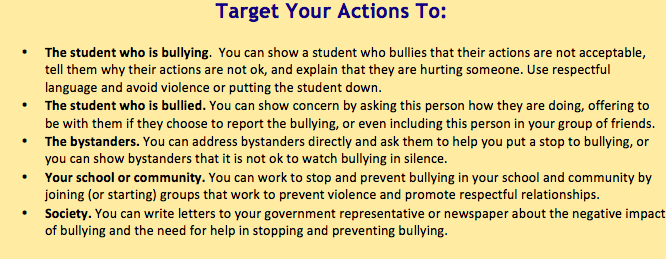The following post was written by guest author, Dr. Shelagh Dunn.
Although I didn’t know it at the time, I’m pretty sure I chose the research topic of my doctoral dissertation for personal reasons. I studied upstanders to bullying by interviewing middle school students who stood up to bullying in their schools. I thought I might someday be helping teachers and schools to lessen bullying. But it turns out that the students I was studying were my teachers. I learned so much about how to be an effective citizen and a decent human being from these student upstanders. You see, I used to see violence in the news and feel horror and pain but not know what to do about it. These students knew these feelings too but they also possessed a wisdom and resolve that I’m still only learning about. I’d like to share some of what I’ve learned with you. We need their knowledge now more than ever.
Why am I talking about bullying right now? Well, it’s common to think of bullying in schools as “kids being kids” or to say “kids can be so cruel” and dismiss the cruelty of bullying as something that children grow out of. I don’t see it this way at all. What I’ve come to learn is that bullying is a microcosm of our society. Children are using their eyes and ears to absorb the world around them and they act it out with one another at school. It is not surprising to hear that right now there are increasing reports of bullying in schools targeting race, faith, and gender, when these very things are being targeted by politicians in the media.
But here’s the thing, stopping bullying is hard, in part because being an upstander is hard. As adults, we do not have this figured out. Most of us don’t know what to do when we witness violence, discrimination or hate, and even if we know what to do, we sometimes don’t do it. In the 1950’s a psychologist named Asch found that when a person is shown lines of obviously different lengths and asked to tell which line is the shortest, they can easily do so… unless they are in a room of people purposefully giving the wrong answer. In these cases, most people will give in and give the same answer as the group even when they know it is wrong. It’s just too hard to be the only one in a group saying something different. There is also another phenomenon acting against us called the “bystander effect” which shows that people will not come to the aid of someone in need as often if there are others around, because we believe that someone else will help. All of this means that there are incredible social forces acting on us to prevent us from intervening when we witness something like bullying, discrimination, or hate-fuelled behavior. We don’t want to be different, we think someone else will do it. Add in the threat of social and physical harm that can come with taking this stuff on and it becomes a very special and unique quality to be an upstander.
So how are some people able to be upstanders? Here’s what the students I interviewed had to say. They all told me that they had been bullied themselves at least once before and had a strong sense of empathy for others being bullied. They all told me that they knew bullying was wrong and they had to do something about it. They all told me that they didn’t care so much about what other students thought of them, they were not afraid to be different. Most of them used specific tactics to intervene using the means that they had available. Most of them took on what I realized was the identity of an upstander – it wasn’t just something they did, it was something they were. It became a part of their moral character to do the right thing even when it’s hard.
We can learn to adopt these qualities and teach them to our kids. Empathy. Resolve. Being unafraid to be different. There are strategies and places to start. As we practice using our empathy, using our voice, and listening to our own sense of right and wrong, even when everyone else around us is silent, here are a very specific set of instructions from these students to their peers and teachers, reprinted here for you to think about.

If you think these instructions might help a school deal with bullying, please try them out. But here is my real challenge to you. If bullying is the microcosm, then we adults live in the macrocosm. Look at the list of actions above. Pick one. Do it today. Sleep. Repeat. Your children are watching.
“In the end, we will remember not the words of our enemies but the silence of our friends.” – Dr. Martin Luther King Jr.
Dr. Shelagh Dunn is a Registered Psychologist in Edmonton, Alberta, Canada. She has a private practice in counselling psychology, with an interest in positive psychology and the health benefits of creating social change.
